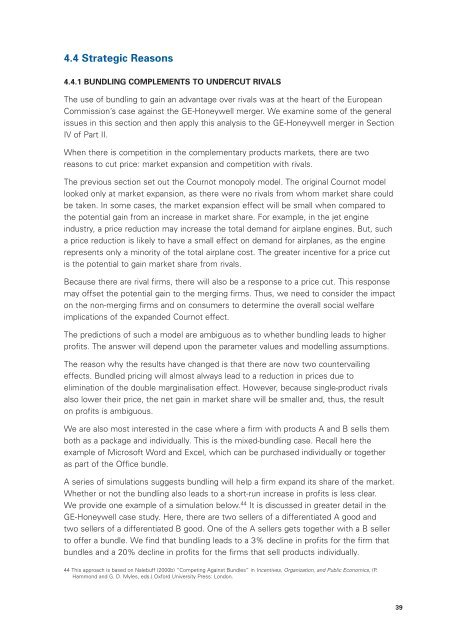Bundling, Tying, and Portfolio Effects: Part 1 Conceptual Issues
Bundling, Tying, and Portfolio Effects: Part 1 Conceptual Issues
Bundling, Tying, and Portfolio Effects: Part 1 Conceptual Issues
Create successful ePaper yourself
Turn your PDF publications into a flip-book with our unique Google optimized e-Paper software.
4.4 Strategic Reasons<br />
4.4.1 BUNDLING COMPLEMENTS TO UNDERCUT RIVALS<br />
The use of bundling to gain an advantage over rivals was at the heart of the European<br />
Commission’s case against the GE-Honeywell merger. We examine some of the general<br />
issues in this section <strong>and</strong> then apply this analysis to the GE-Honeywell merger in Section<br />
IV of <strong>Part</strong> II.<br />
When there is competition in the complementary products markets, there are two<br />
reasons to cut price: market expansion <strong>and</strong> competition with rivals.<br />
The previous section set out the Cournot monopoly model. The original Cournot model<br />
looked only at market expansion, as there were no rivals from whom market share could<br />
be taken. In some cases, the market expansion effect will be small when compared to<br />
the potential gain from an increase in market share. For example, in the jet engine<br />
industry, a price reduction may increase the total dem<strong>and</strong> for airplane engines. But, such<br />
a price reduction is likely to have a small effect on dem<strong>and</strong> for airplanes, as the engine<br />
represents only a minority of the total airplane cost. The greater incentive for a price cut<br />
is the potential to gain market share from rivals.<br />
Because there are rival firms, there will also be a response to a price cut. This response<br />
may offset the potential gain to the merging firms. Thus, we need to consider the impact<br />
on the non-merging firms <strong>and</strong> on consumers to determine the overall social welfare<br />
implications of the exp<strong>and</strong>ed Cournot effect.<br />
The predictions of such a model are ambiguous as to whether bundling leads to higher<br />
profits. The answer will depend upon the parameter values <strong>and</strong> modelling assumptions.<br />
The reason why the results have changed is that there are now two countervailing<br />
effects. Bundled pricing will almost always lead to a reduction in prices due to<br />
elimination of the double marginalisation effect. However, because single-product rivals<br />
also lower their price, the net gain in market share will be smaller <strong>and</strong>, thus, the result<br />
on profits is ambiguous.<br />
We are also most interested in the case where a firm with products A <strong>and</strong> B sells them<br />
both as a package <strong>and</strong> individually. This is the mixed-bundling case. Recall here the<br />
example of Microsoft Word <strong>and</strong> Excel, which can be purchased individually or together<br />
as part of the Office bundle.<br />
A series of simulations suggests bundling will help a firm exp<strong>and</strong> its share of the market.<br />
Whether or not the bundling also leads to a short-run increase in profits is less clear.<br />
We provide one example of a simulation below. 44 It is discussed in greater detail in the<br />
GE-Honeywell case study. Here, there are two sellers of a differentiated A good <strong>and</strong><br />
two sellers of a differentiated B good. One of the A sellers gets together with a B seller<br />
to offer a bundle. We find that bundling leads to a 3% decline in profits for the firm that<br />
bundles <strong>and</strong> a 20% decline in profits for the firms that sell products individually.<br />
44 This approach is based on Nalebuff (2000b) “Competing Against Bundles” in Incentives, Organization, <strong>and</strong> Public Economics, (P.<br />
Hammond <strong>and</strong> G. D. Myles, eds.) Oxford University Press: London.<br />
39

















